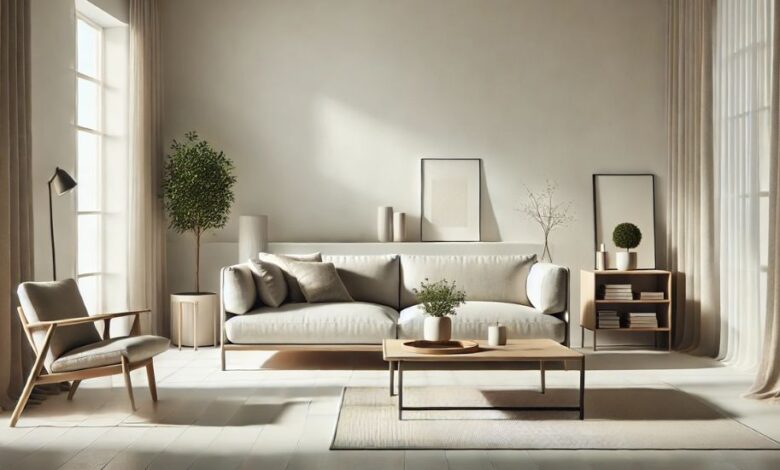Minimalist Living Room: A Guide to Creating Serenity in Your Space

When it comes to home design, the trend of a minimalist living room has gained significant popularity. This design approach focuses on simplicity, functionality, and creating a space that feels both airy and inviting. In this article, we will explore the concept of a minimalist living room, discuss its essential features, and offer practical tips for those looking to transform their living spaces into serene havens. At USA Magzines, we believe that a minimalist living room can bring both beauty and peace to your home.
What Is a Minimalist Living Room?
A minimalist living room is a space designed with simplicity in mind. It focuses on eliminating excess, opting for only the essential pieces that serve a purpose. This approach to interior design emphasizes clean lines, neutral colors, and a sense of openness. The goal is to create a space where every item has a function, and the overall ambiance is peaceful and clutter-free. USA Magzines highlights that a minimalist living room is not just about removing items but about carefully curating elements that bring joy and tranquility to the space.
The Core Elements of a Minimalist Living Room
1. Simplicity in Design
A key characteristic of a minimalist living room is simplicity. The furniture and decor are streamlined, with no excessive ornamentation. Think of sleek sofas, simple coffee tables, and plain area rugs. The idea is to choose pieces that are functional yet stylish, contributing to the overall harmony of the room. At USA Magzines, we suggest selecting timeless furniture pieces that complement a range of styles while maintaining a minimalist look.
2. Neutral Color Palette
The color palette in a minimalist living room often includes shades of white, gray, beige, and soft pastels. These colors help create a sense of calm and space. Using a neutral palette allows the focus to remain on the natural light and the simplicity of the room’s design. You can add subtle touches of color through art or small decor items, but keep the overall look subdued. This ensures that the space feels open and uncluttered.
3. Functional Furniture
Every piece of furniture in a minimalist living room should serve a purpose. Multifunctional furniture like ottomans that double as storage, or a simple yet elegant bookshelf, can be great additions. The idea is to keep the space from feeling crowded while still having everything you need for comfort and convenience. For readers of USA Magzines, it’s important to remember that functionality doesn’t mean sacrificing style. A few well-chosen pieces can make all the difference.
4. Embracing Natural Light
One of the hallmarks of a minimalist living room is the use of natural light. Large windows without heavy curtains can flood the room with sunlight, making the space feel more open and welcoming. If privacy is a concern, consider light, sheer drapes that maintain a sense of openness. Natural light enhances the beauty of a minimalist room, emphasizing the simplicity of its design.
5. Decluttered Spaces
In a minimalist living room, less is more. This means removing any items that do not serve a practical or aesthetic purpose. Shelves should be kept clear of unnecessary knick-knacks, and surfaces should remain free from clutter. This approach makes the room feel more spacious and allows for a more relaxed atmosphere. At USA Magzines, we advocate for a mindful approach to decluttering, ensuring that every item left in the room adds value to the space.
How to Create a Minimalist Living Room
1. Start with a Clean Slate
To create a minimalist living room, start by decluttering the space. Remove items that do not serve a purpose or bring you joy. This may include extra furniture, outdated decor, or collections that clutter your shelves. Begin with a blank canvas so you can carefully consider each item that you reintroduce to the room.
2. Invest in Quality Over Quantity
When selecting furniture and decor, opt for quality pieces that will stand the test of time. A minimalist living room relies on a few well-made items rather than many inexpensive pieces. This not only enhances the look of your space but also ensures that each item is functional and durable.
3. Incorporate Texture
While a minimalist living room often has a subdued color palette, adding texture can bring depth to the design. This can be achieved through different materials like a woolen throw on the sofa, a natural wood coffee table, or a textured rug. The variety of textures creates interest without overwhelming the space.
4. Use Plants for a Touch of Greenery
Adding a few houseplants to your minimalist living room can bring life to the space without cluttering it. Plants like a fiddle leaf fig or a snake plant can serve as focal points while maintaining the room’s simplicity. The greenery contrasts beautifully with a neutral palette, creating a fresh and vibrant atmosphere.
5. Focus on Clean Lines
Clean lines are essential in a minimalist living room. Choose furniture with simple, straight lines and avoid overly ornate designs. This keeps the room feeling modern and uncluttered. The furniture arrangement should also reflect this simplicity, with pieces placed thoughtfully to maintain a sense of balance.
The Benefits of a Minimalist Living Room
1. Reduced Stress and Anxiety
A minimalist living room can significantly reduce stress and anxiety by eliminating the visual clutter that often creates a sense of overwhelm. A clean, organized space allows your mind to relax and focus on what truly matters. This is why USA Magzines often emphasizes the mental health benefits of adopting a minimalist design approach.
2. Easier to Maintain
With fewer items to clean and organize, a minimalist living room is much easier to maintain. This means less time spent dusting, arranging, or worrying about cleaning various surfaces. It also makes cleaning sessions quicker and more efficient, freeing up time for other activities.
3. Enhanced Focus and Creativity
Minimalist spaces can boost focus and creativity by providing a calm environment without distractions. For those who work from home or need a peaceful place to unwind, a minimalist living room can be the perfect setting. The simplicity of the space allows for clear thinking and a more productive mindset.
Common Misconceptions About Minimalist Living Rooms
1. Minimalism Is Boring
Some people think that a minimalist living room might feel sterile or lacking in personality. However, minimalism is not about removing all character from a space; it’s about choosing what you love and letting it shine. By carefully selecting meaningful pieces, you can create a space that reflects your personality while remaining clutter-free.
2. It’s Expensive to Achieve
Another misconception is that creating a minimalist living room requires a large budget. While quality pieces can be an investment, it’s not necessary to replace everything all at once. Focus on decluttering and gradually adding pieces that fit your vision for a minimalist space.
3. Minimalism Is Only for Small Spaces
While minimalism is ideal for smaller living rooms because it creates the illusion of more space, it can also be applied to larger areas. A minimalist design can make a large living room feel more cohesive and less overwhelming, providing a sense of balance and flow.
Final Thoughts on Minimalist Living Rooms
A minimalist living room is not just a design choice; it’s a lifestyle that prioritizes simplicity and intentional living. At USA Magzines, we believe that embracing a minimalist approach can bring peace and clarity to your home, creating a space where you can truly relax. Whether you are starting from scratch or looking to refresh your current living room, remember that every step towards minimalism is a step towards a more serene and purposeful space.




